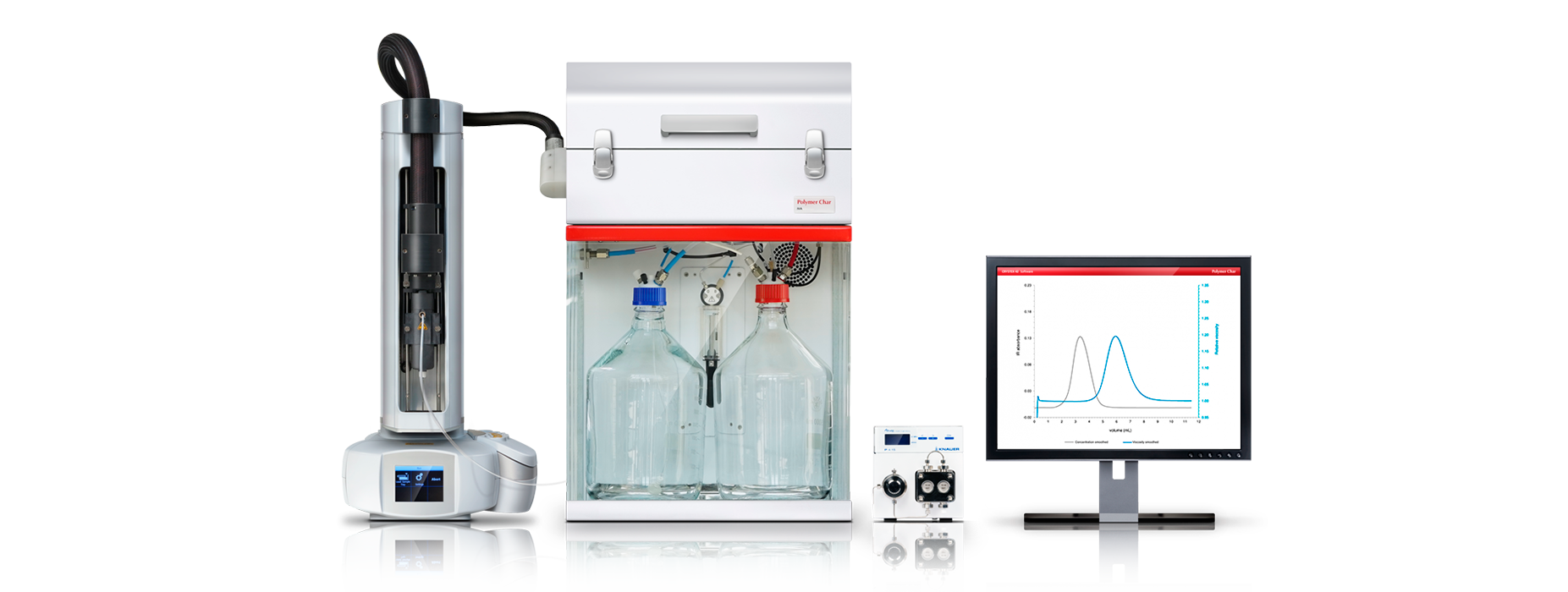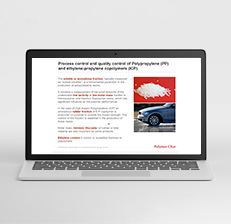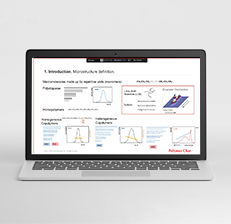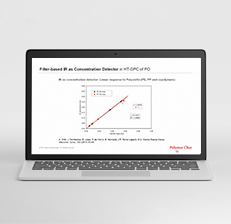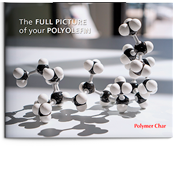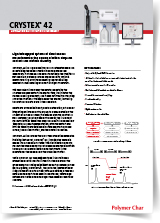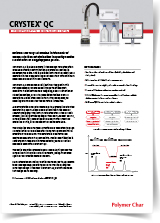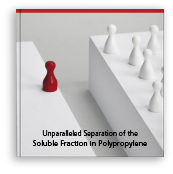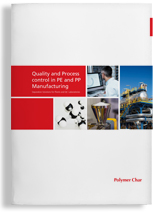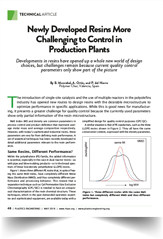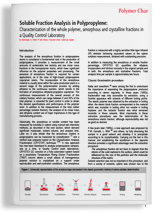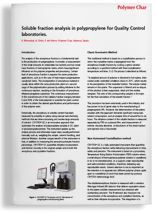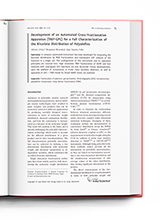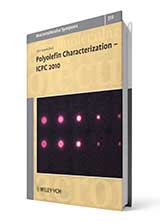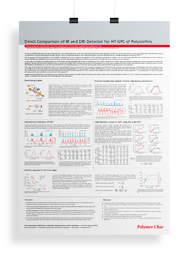December 2013
By B. Monrabal, A. Ortín, P. Del Hierro. Polymer Char, Valencia, Spain.
Introduction
The analysis of the amorphous fraction is a fundamental task in the production of polypropylene. It provides a measurement of the small amounts of undesirable low tacticity and low molar mass fractions in homopolymer resins, which have significant influence on the polymer properties and processing. Certain level of amorphous fraction is required for some production applications, such as in the case of high-impact polypropylene copolymer resins. The incorporation of amorphous material is usually done within the same production plant at a second stage of the polymerization process by adding ethylene to the continuous reaction, resulting in the formation of amorphous ethylene-propylene copolymer. The continuous measurement of the overall amount of this rubbery fraction (ranging between 0 and 30% of the total polymer) is essential for plant control in order to obtain the desired specifications and performance of the polymer resin. In addition to the measurement of the total rubber percentage (soluble fraction), the analysis of its molar mass and ethylene content are of major importance in this type of manufacturing process.
Historically, the amorphous or soluble content has been measured by solubility in xylene using manual wet chemistry methods that are time-consuming and involve large amounts of solvent. CRYSTEX QC is an innovative approach that automates the analysis of polypropylene samples in QC plant or processing laboratories. The instrument speeds up the analysis process and eliminates major steps usually performed manually such as, weighing the sample, solvent handling, and external filtration. Another unique benefit of the instrument is that, in addition to measuring the amorphous/soluble fraction percentage, CRYSTEX QC quantifies ethylene incorporation and intrinsic viscosity in the original sample and in both the amorphous and crystalline fractions. The inclusion of intrinsic viscosity lies in the importance of a simple and practical approach to estimate molar mass of the three different fractions.
Classic Gravimetric Method
This traditional method is based on a crystallization process in which the crystalline matrix is segregated from the amorphous/ soluble fraction by cooling a xylene solution according to a specified method with fixed crystallization temperature and time. (1-2) The process is described as follows:
“A weighed amount of polymer is dissolved in hot xylene, then cooled under controlled conditions down to 25ᵒC, which results in the precipitation of the insoluble fraction. The soluble matter remains in the xylene. The suspension is filtered and an aliquot of the solution is then evaporated, dried and the residue weighed. The ratio of the corresponding weights is the basis for the final calculation of the soluble fraction.”
This procedure has been extensively used in the industry and has proven to be of great value to the manufacturing of polypropylene (PP). However, the determination of the xylene solubles with this approach demands significant manpower, solvent consumption, and an analysis time of around five to six hours. The ethylene content of the soluble fraction is measured separately by FTIR on a pressed film; and measurement of intrinsic viscosity demands re-dissolution of the dried fraction and injection into a Viscometer.
New Automated Crystallization method
CRYSTEX QC is a fully automated instrument that quantifies the amorphous fraction while delivering improvements in time, safety and precision. The instrument is based on a proprietary Temperature Rising Elution Fractionation (TREF) column where a small aliquot of homogeneous polymer solution is crystallized, in di- or tri-chlorobenzene, on a support under reproducible and well-controlled conditions, therefore, delivering very reproducible results. Solvent selection is not so important as the intention is to separate two different polymer phases quite apart in crystallinity (3) and it has been proven by previous CRYSTEX methodology (4-6).
The soluble/amorphous fraction is measured with a sensitive filter-type Infrared (IR) detector that delivers equivalent values to the xylene solubles measurement but obtained with outstanding precision. The IR detector also measures the concentration of the amorphous and crystalline fractions, as well as their ethylene incorporation. The integration of a capillary viscometer provides an automated measurement of intrinsic viscosity of the whole sample and both amorphous and crystalline fractions.
The schematics of the system are presented in Figure 2.
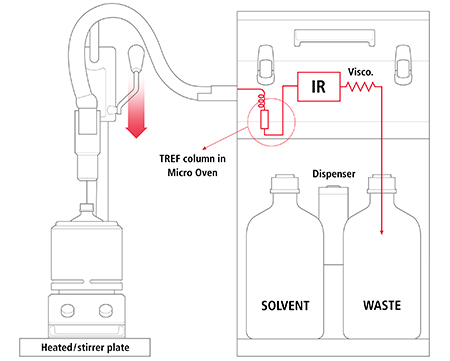
Figure 2: Schematic diagram of CRYSTEX QC.
All the analyst is required to do is put an approximate amount of sample in a disposable bottle, place it in the stirred-heated plate, and lower a handle to pierce the bottle’s septum with a needle. The automated process is as follows:
- Filling of the disposable bottle up to 100 or 200 mL (depending on whether pellets or powder samples are analyzed) with solvent preheated at 160ºC and initiate stirring in the heated plate.
- An aliquot of the solution is pumped through the TREF column at 160ºC into the detectors to measure the whole sample concentration, ethylene incorporated and intrinsic viscosity (first eluted peak in Figure 3).
- A new aliquot of the solution is injected into the middle of the column at 160ºC, the flow is stopped and the column temperature is reduced rapidly down to controlled ambient temperature, staying there for a specified amount of time to precipitate the crystalline fraction. The column is then flushed to elute the amorphous soluble fraction peak (second peak in Figure 3). The ratio of this peak area by the one of the whole sample provides the soluble percentage in the sample. As the soluble material passes through the IR and Viscometer detectors, ethylene content and intrinsic viscosity of this fraction are also measured.
- Temperature is raised rapidly up to 160ºC with stop flow to re-dissolve the crystalline fraction and after a pre-set time of a few minutes, this fraction is eluted through both IR and viscometer detectors.
- The column is rinsed, and the instrument is ready for a new sample analysis.
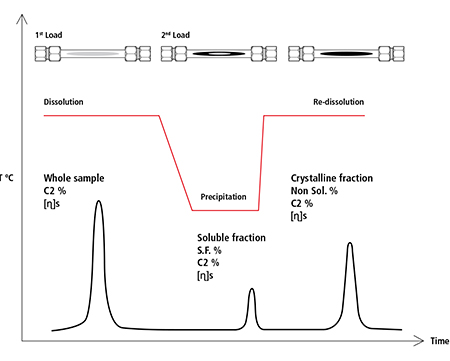
Figure 3: Elution of the whole sample and PP fractions in a TREF column.
Results and discussion
Reproducibility is remarkable for the soluble fraction determination as well as for ethylene content and intrinsic viscosity determinations. Table 1 shows data obtained from seven replicate analyses using four grams of sample for a set of three polypropropylene products with average standard deviations shown for each type of measurement.
No additional experimental effort is required, since the data is collected by the IR and viscometer detectors during the automated analysis providing a measurement of the ethylene content and intrinsic viscosity of all polymer fractions.

Table 1: Soluble fraction, ethylene content and intrinsic viscosity of three different PP products.
Conclusions
A new method that measures the soluble fraction in polypropylene resins has been developed based on a TREF crystallization approach.
The analytical process is fully-automated with no need of weighing, filtration or solvent handling.
The new method is especially suitable for quality control in polypropylene plants, although application for the measurement of extractables in Polyethylene resins is in development.
The total time of analysis is two hours, and samples are analyzed one at a time in disposable bottles. Total volume consumption is as low as 180 mL for a two-gram sample analysis. Analysis of four grams of resin in the form of powder can be done for enhanced sample representativeness.
In addition to the soluble fraction (equivalent to xylene solubles), the new system measures automatically and simultaneously, ethylene content and intrinsic viscosity in both amorphous and crystalline fractions, and in the whole sample.
References
- ASTM standard D5492-10, ASTM
- ISO standard 6427, 1992, ISO standard 16152, 2005
- Monrabal , Encyclopedia of Analytical Chemistry, John Wiley & Sons, 2000 pages 8074-8094.
- A. Ortín, B. Monrabal, M. D. Romero, LCGC Europe Vol 19 Issue Suppl., March 2006, 32.
Romero, B. Monrabal, A. Ortín, Pittcon 2001 U.S.A. - Romero, A. Ortín, B. Monrabal, J.R. Torres Lapasió, M.C. García Álvarez-Coque, Macromol. Symp. 312 (2012) 157
